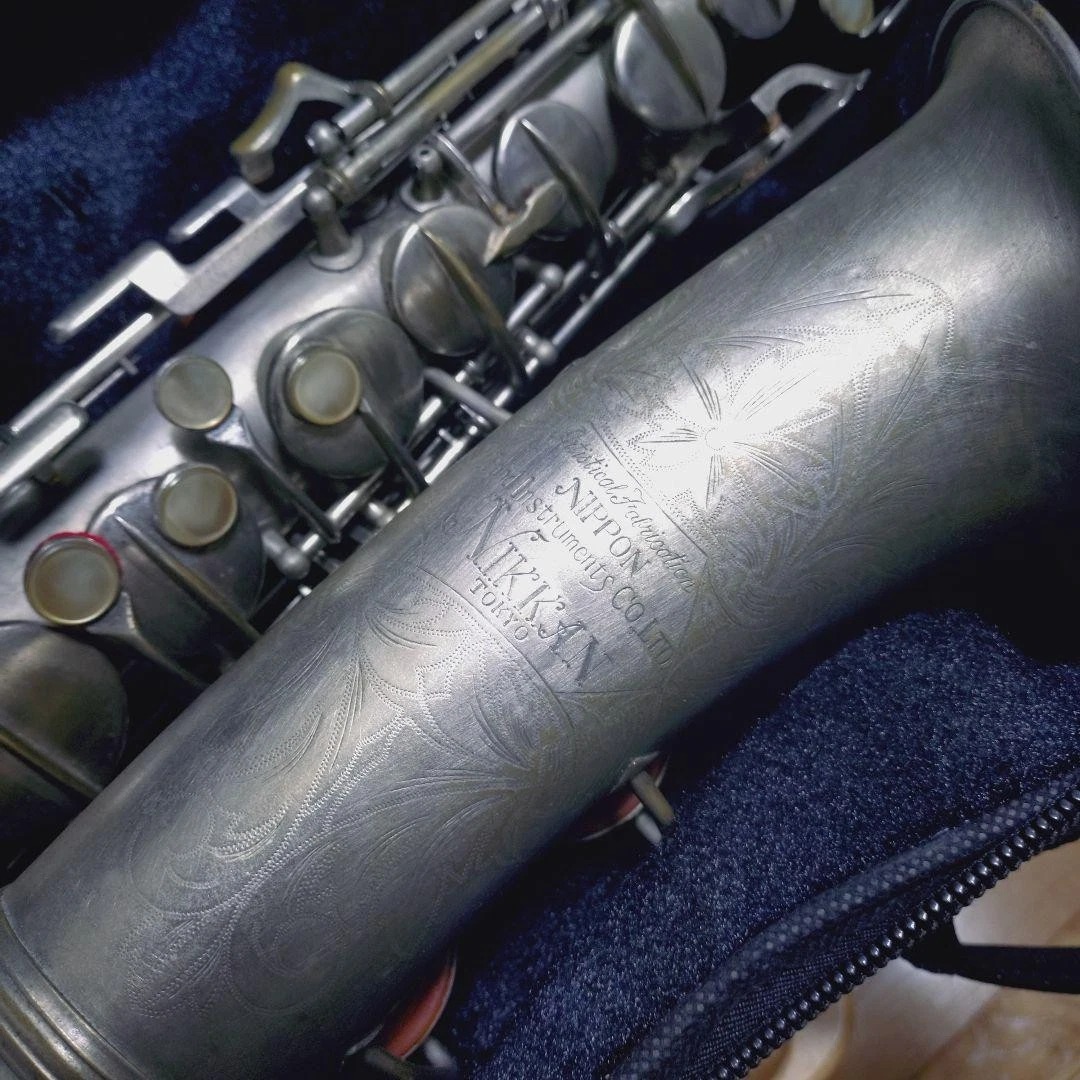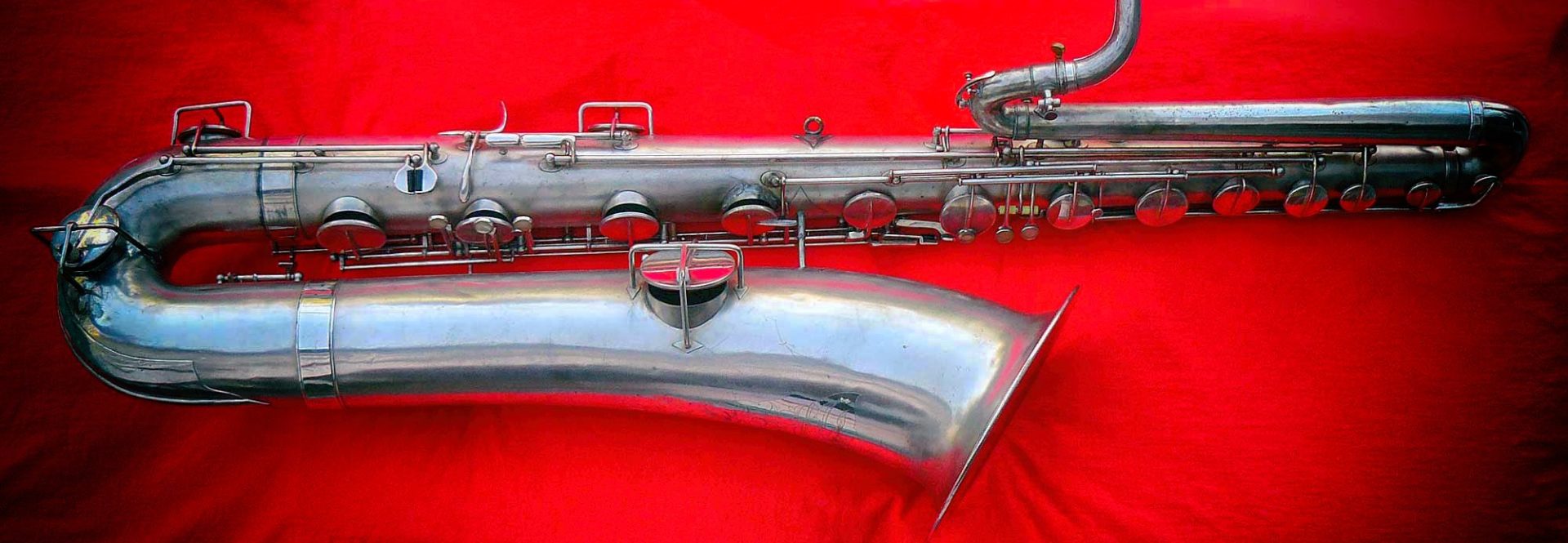
The other day something crossed my radar screen that I hadn’t seen before: a vintage Nikkan alto on eBay that looked ever so much like a clone of an early 6M. Now I am purposely not providing any links to the sales, since something seems a bit hinky: The same horn and photos appear for sale by three different sellers, and with three different prices.
This article isn’t so much about the sale of the horn per say, but about the sax itself, and that it exists at all.
Now admittedly I am not up on Japanese-made saxophones. Between my colleague Pete Hales and myself, those really were more Pete’s area of expertise. But more on that below. I am however, quite knowledgeable about vintage American-made horns, and have about 10 in my personal collection of vintage saxophones—with Conns overly represented ![]() .
.
The more I studied the photos of this Nikkan alto, the more it appeared to me that it was yet another example of the reverse engineering that Japan became infamous for, and that ultimately had led to the demise of so so many Western companies all over Europe and North America.
Nikkan company history
Prior to seeing this alto, I don’t recall ever seeing or hearing about the Nikkan brand before. But then then since I don’t spend my life studying or researching Japanese-made saxophones, that kinda’ makes sense. However, even as I researched the brand for this article, I was surprised how little information was available.
My hardcopy books on saxophone history had exactly zero for the company—yes, even my English language books, or books written about all brands of saxophones, and not focusing solely on those from European locales.
So down the rabbit hole of Internet-based research I went. Weirdly enough, not a lot there either, and what was, was quite murky, and often contradictory depending on which frame of reference it was written from.
One of the most concise, and likely authoritative, can be found in an article by Jay Metcalf, in which he interviewed the current President of Yanagisawa. Another valuable source of info comes from the Yamaha company history page, and this page about their Xeno Series trumpets.
Combined together, Nikkan’s history looks like this:
- Prior to approx. 1900, there were no Western instruments in Japan.
- When Western instruments started to enter Japan, there was no one able to repair them.
- The first instrument repairers in Japan were the craftsmen who repaired the decorations damaged in the war with Russia, et al. One of these craftsmen was Takutaro Yanagisawa, the grandfather of the current president of Yanagisawa saxophones.
- Tokutaro Yanagisawa, and Sentaro Egawa, jointly founded Egawa Seisakusho, the first musical instrument repair company in Japan.
- As Japan entered WWII, Egawa Seisakusho, together with Nippon Kangakki Seizoshu (Nikkan), became part part of Japan’s war effort in WWII.
- Developing roughly at the parallel time, the following chart depicts the beginnings of Yamaha’s musical evolution.
- In 1963, Yamaha assisted Nikkan in building a new wind instrument factory in Saitama, Japan.
- Yamaha took over Nikkan circa 1970.
Just as an aside
OK, this section took me about 10 hours to research. Why? Because I don’t read or speak Japanese. ![]() It is way easier to stay in my lane and research vintage German horns. Just staying.
It is way easier to stay in my lane and research vintage German horns. Just staying. ![]()
What does this Nikkan look like?
Judge for yourself, to me it looks like a 1930s Conn. Funny thing though, despite it not having a serial #, based on the info above, it is likely circa the early to mid 1960s.
A comparable 6M in appearance
Through my colleague Brian at Get A Sax, I found this early Conn 6M #252624, which would make it a transitional horn from circa 1932. As of the time of writing, yes, it is available for purchase if you are looking for horn like this.
The Nikkan alto vis-a-vis a Conn 6M
To get an idea of how close these horns are design and appearance, I put together the following slides for you. A couple of things to keep in mind however:
- This only deals with what we can see. Internal dimensions are obviously not available on either model for comparison/contrast.
What are the obvious differences?
- The Nikkan doesn’t have rolled tone holes (RTH).
- The Nikkan is lacking a serial #, and other identifying stamping the Conn has.
- The left palm keys on the Nikkan are slightly more angular.
- The Nikkan has a different silver finish. Not the same silver plate as the 6M has.
- Obviously there is no naked lady engraved on the bell of the Nikkan.
Bottom line: Helen’s totally biased opinion
To me, this Nikkan looks like a cheap-ass copy of a Conn 6M. It simply looks cheap. From its finish—what is that anyway? it surely isn’t silver plate—to its left palm keys and bell key guards, everything about this horn screams: I’M A KNOCK OFF 
Why am I so hard on this Nikkan? I admit it: I am a European horn snob. I look at some of the German-built horns from the 1930s, that were also very similar American saxophones, and they don’t look nearly as cheap.
Brands like FX & GH Hüller, Julius Keilwerth, or Oscar Adler for example, were not built similar to French designs like Selmer or Buffet, rather more like American saxophones like Conn and Martin. A number of brands even were sporting the “Mercedes-style” low C key guard. Although the models of these German horns are 3 decades older than the Nikkan, yet look just as advanced—in some cases more so—than the American models they were styled after.
Why did I write about this horn to begin with?
When I first noticed this sax I found it intriguing because of its history with Yamaha, and ultimately Yanagisawa. Now truth be told, my experience with Yanagisawa is limited. I have played a couple of their new pro baris that were extremely nice, and have also played some of their smaller pro horns, but I personally have never owned one.
On the other hand, my friend and colleague Pete Hales, wrote numerous articles about the brand on his former website: thesax.info
Pete did a fantastic pictorial history of the various Yani models that vanished along with his domain. Much like I did with Pete’s Olds Super article a few weeks ago, I will be republishing the articles here, on Bassic Sax, and updating any expired links.
Since I had no background history on the company—or the history of saxophone making in Japan in general—I decided that this Nikkan alto would be a good one to start me down my own area of research first, before I tackled updating Pete’s previous articles.





























